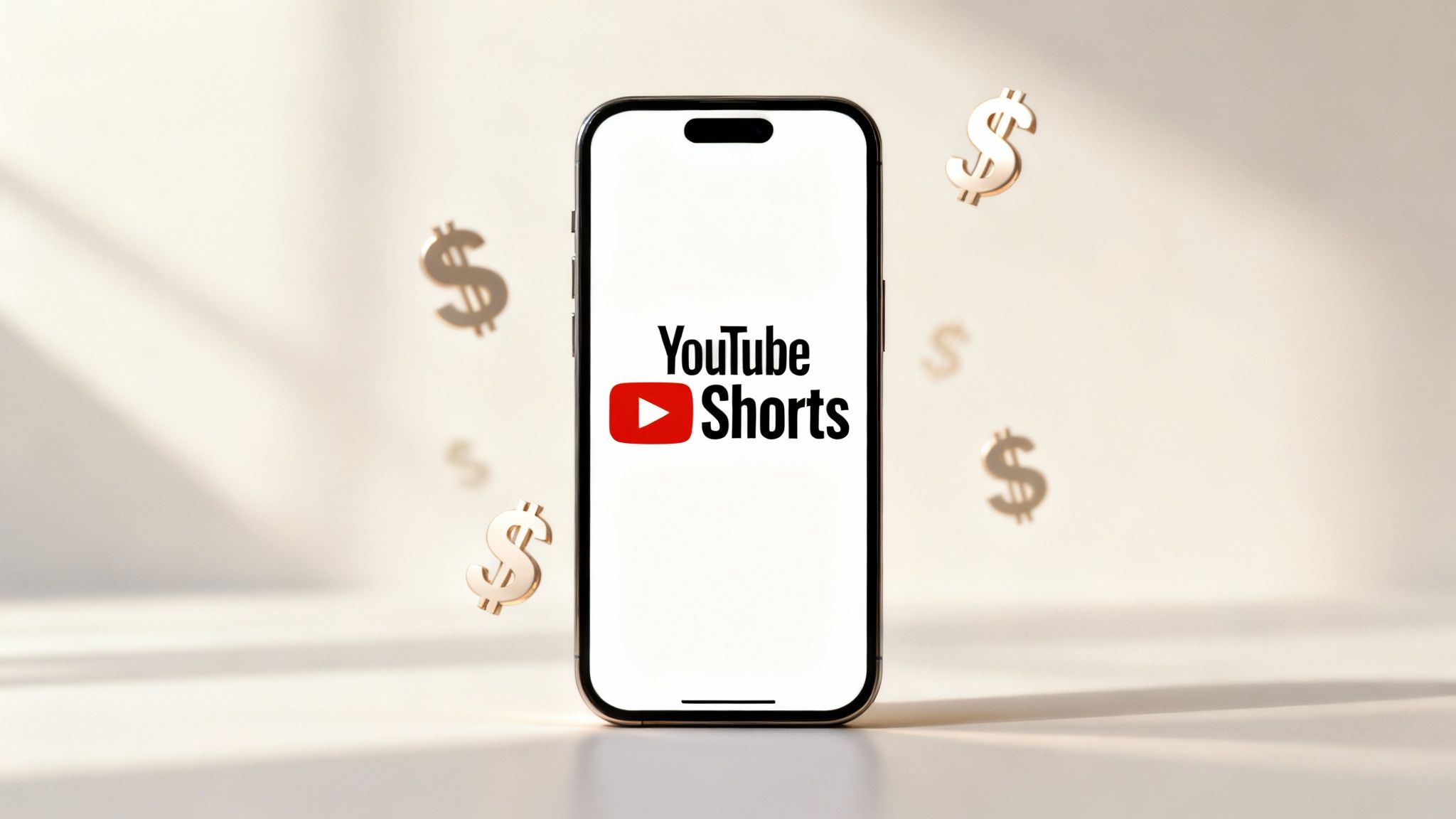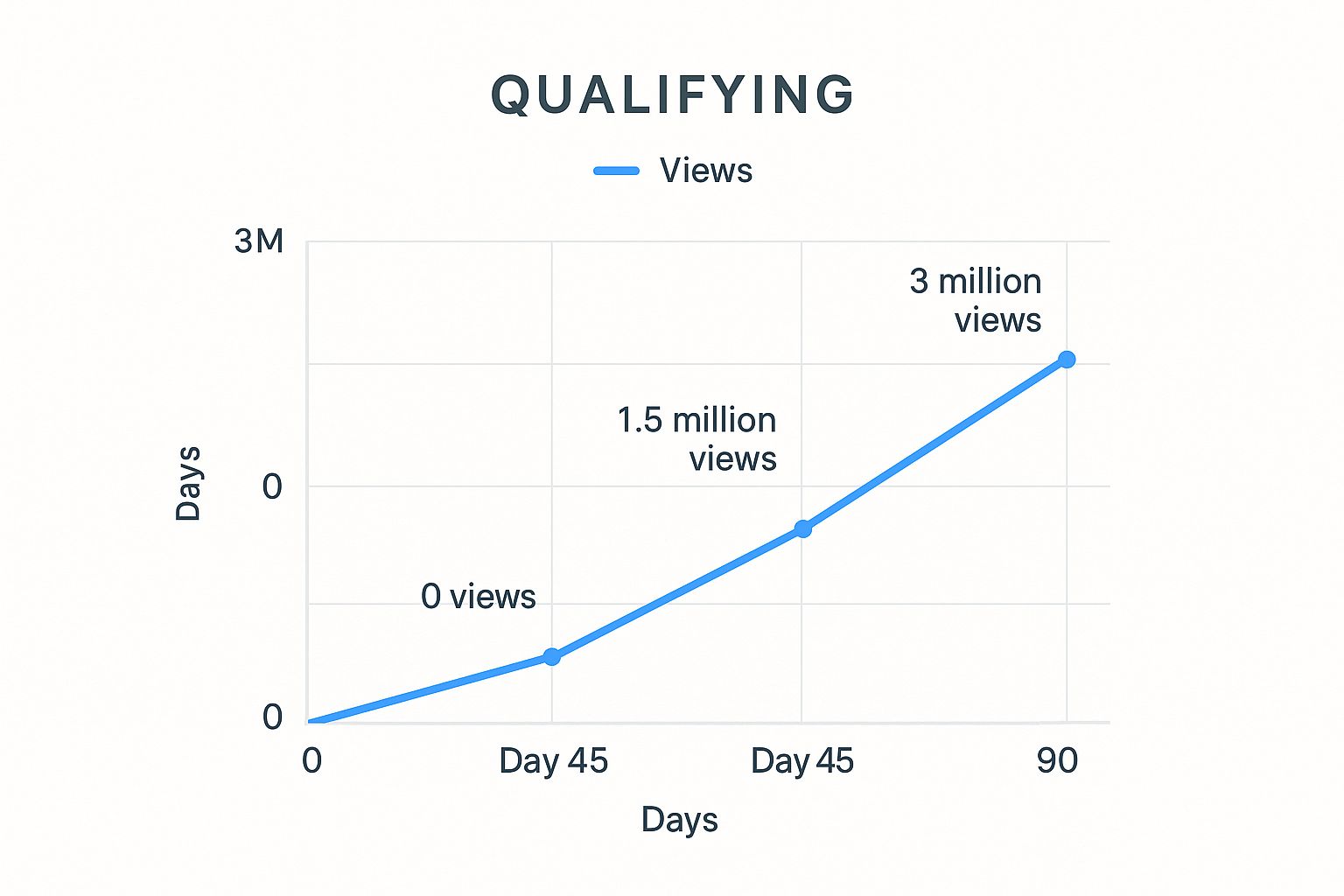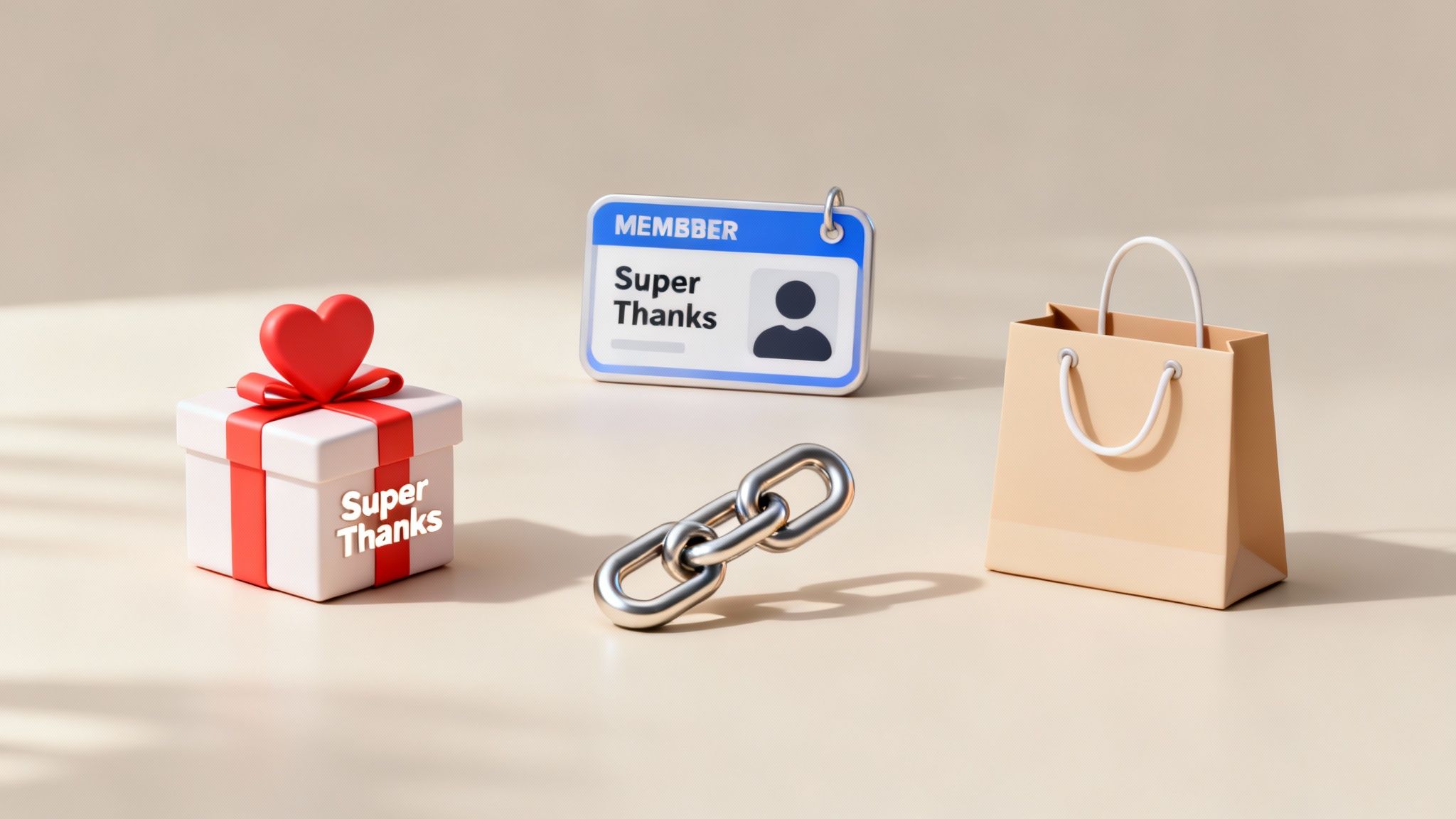How to Monetize YouTube Shorts and Maximize Earnings
Making money from YouTube Shorts isn't some secret club anymore. It's now baked right into the YouTube Partner Program (YPP), letting creators get a piece of the ad revenue pie. But first, you have to hit a couple of key milestones to get your foot in the door—specifically, hitting 1,000 subscribers and racking up 3 million Shorts views in a 90-day window.
The New Era of YouTube Shorts Monetization

What started as a fun little feature has quickly become a serious income stream. By integrating Shorts into the YPP, YouTube sent a clear message: short-form video is a legitimate career path, not just a gimmick for channel growth.
And the opportunity is staggering. YouTube Shorts are pulling in over 90 billion daily views across the globe. With more than two billion users watching every month, that massive audience creates a huge financial pool for creators. The scale is almost hard to comprehend, and if you're curious about the numbers, you can dig deeper into Shorts viewership statistics at awisee.com.
Key Monetization Pathways
So, how do you actually start earning? YouTube has laid out two main paths for creators to join the YPP, depending on where you are in your journey.
To give you a clear picture, here's a quick breakdown of what it takes to get in.
YouTube Partner Program Requirements for Shorts Creators
Eligibility Metric | Requirement |
|---|---|
Subscribers | At least 1,000 subscribers |
Public Shorts Views | At least 3 million valid public Shorts views in the last 90 days |
This is the main path to unlocking full ad revenue sharing. There's also a lower-tier option focused on Fan Funding (like Super Thanks) that requires 500 subscribers and 3 million Shorts views, but this won't get you a cut of the ad money just yet.
This table really just covers the fast track for Shorts-focused creators. Keep in mind, the traditional path of 1,000 subscribers and 4,000 public watch hours on your long-form videos is still a valid way to get into the YPP.
Here's the core idea behind Shorts monetization: YouTube pools all the revenue from ads that run between Shorts. From there, they distribute a portion to eligible creators, who then keep 45% of their allocated share.
This model makes one thing crystal clear: consistency is everything. The more engaging, high-quality Shorts you pump out, the bigger your slice of the pie.
If you're trying to scale your production without burning out, using an AI-powered tool can be a lifesaver. Something like https://www.clipshort.co/ can help you turn ideas into viral-style videos fast, letting you focus on the creative side while the tech handles the heavy lifting. The bottom line is that creating content people actually want to watch is how you tap into this revenue system.
Qualifying for the YouTube Partner Program
Getting into the YouTube Partner Program (YPP) is the first major milestone for any serious creator. It’s the official starting line where your views finally begin to translate into actual dollars.
While the numbers might look intimidating at first glance, they’re really just there to reward creators who are consistently putting out content that people want to watch.
YouTube recently updated its eligibility rules, which is great news for Shorts creators. The barrier to entry is now much lower. You can get your foot in the door with just 500 subscribers and 3 million Shorts views in the last 90 days. This unlocks Fan Funding features like Super Thanks, letting your most loyal viewers support you directly.
Of course, the big goal is full ad revenue sharing. For that, you'll still need to hit 1,000 subscribers along with a higher view count. This tiered system is a smart move by YouTube—it acknowledges the explosive, fast-paced growth that's unique to Shorts. You can find a bit more on these updated monetization methods on stackinfluence.com.
Hitting these milestones is all about building momentum. I've seen countless creators get stuck for months, then suddenly see their growth skyrocket once they figure out what clicks with the audience.
This is what that growth often looks like. It's not a straight line up.

As the chart shows, the journey usually starts slow. Then, once the algorithm gets a taste of your content and starts showing it to the right people, things can take off dramatically.
Strategies to Hit Your YPP Goals
Getting 3 million views in 90 days isn't about luck; it's about strategy. You have to create videos that are practically designed to be shared and watched over and over.
Think about a creator in the DIY space. Instead of posting random projects, they could launch a series called "60-Second Home Hacks." Each Short solves a real, common problem in a super quick and visual way. The first few videos might only get a handful of views, but by the tenth one, something could catch fire.
A single viral Short can easily rack up a million views, sending a wave of new subscribers your way and even breathing new life into your older videos.
Key Takeaway: Stop trying to make one single viral video. Instead, focus on building a library of high-quality, consistent Shorts around a specific theme. This gives the algorithm more to work with, dramatically increasing the chances that one (or more) of your videos will pop.
To put this into practice, here’s what you need to focus on:
-
Jump on Trending Audio: Don't underestimate the power of a popular sound. The algorithm actively pushes Shorts that use trending audio, giving you an easy visibility boost.
-
Hook Them Fast: The first three seconds are everything. Seriously. You have to stop the scroll. Start with a bold claim, a weird visual, or a question that makes them need to know the answer.
-
Nail Your Titles & Hashtags: Keep titles short and punchy. Use a mix of broad hashtags (like #DIY) and super-niche ones (like #ikeahack) to show up in more searches.
When you consistently apply these tactics, you create a powerful feedback loop. More views bring more subscribers, which signals to YouTube that your content is worth watching, which leads to even more views. This is how you build the momentum to smash those YPP goals and finally start monetizing your work.
Understanding Shorts Ad Revenue and RPM
Getting into the YouTube Partner Program is a huge milestone, but it's really just the starting line. Now, we need to get into the nitty-gritty of how money actually flows from viewer ads into your pocket. For Shorts, the system works a little differently than it does for your standard long-form videos.
https://www.youtube.com/embed/B_SA5jdp7oE
Instead of ads playing right before or during your video, YouTube pools all the ad money from the entire Shorts feed. From that big pot, they first take out a slice to cover music licensing fees—a necessary evil for a format so reliant on trending audio.
What's left is called the Creator Pool, and this is where you come in.
Your share of the Creator Pool is based on your total views. If your Shorts rack up 1% of all monetized views that month, you get 1% of the funds from that pool. From that allocation, you keep 45%. It’s a 45/55 split, which is the reverse of the long-form model, mainly because of the complex music licensing involved.
The Role of RPM and Audience Location
This is where things get really interesting, and where strategy comes into play. Not all views are created equal. Your earnings are massively swayed by a metric called RPM, or Revenue Per Mille (what you earn for every thousand views).
Your RPM is almost entirely dictated by where your audience is. Why? Because advertisers pay vastly different amounts to reach people in different countries. A view from a high-income country is simply worth more.
For example, a creator with a big US audience might see an RPM around $0.328 per 1,000 views. In contrast, someone with a massive audience in a high-volume market like India could see an RPM closer to $0.008. You can dive deeper into these numbers by checking out these additional RPM insights at air.io.
The geography of your audience can have a staggering effect on your bottom line. Take a look at this breakdown.
Sample YouTube Shorts RPM by Country
Here's a quick look at how much RPMs can vary by country. It really drives home how much audience location matters for your ad revenue.
Country | Estimated RPM (USD) |
|---|---|
United States | $0.328 |
United Kingdom | $0.290 |
Canada | $0.265 |
Australia | $0.250 |
Brazil | $0.025 |
India | $0.008 |
As you can see, the difference between a viewer in the U.S. versus a viewer in India is enormous from a purely financial perspective.
The takeaway is clear: your audience's location can have a bigger impact on your ad revenue than almost any other factor. A million views from the U.S. might earn you over $300, while the same number from India could bring in less than $10.
Crafting a Global Content Strategy
So, how do you turn this knowledge into a real strategy? The goal is to build a global audience. This doesn't mean ditching your current viewers, but it does mean creating content with a broader, more universal appeal to attract those high-RPM eyeballs.
Here are a few ways to think about it:
-
Focus on Visual Storytelling: Content that doesn't rely on a specific language has a much better shot at going global. Think of those oddly satisfying cleaning videos, incredible transformations, or silent comedy bits. The visuals do all the talking.
-
Use Universally Understood Themes: Joy, surprise, humor—these are human emotions, not cultural ones. Craft your content around these core experiences to connect with viewers no matter where they are.
-
Leverage Trending Audio: A popular sound or song often becomes a global phenomenon on its own. Hopping on these trends gives your Shorts a built-in passport to be discovered by a wider international audience.
By thinking globally, you can pull in viewers from high-RPM countries and boost your earnings, all while still enjoying the massive view counts that other regions offer. It's this balanced approach that builds a truly sustainable and profitable Shorts channel.
Expanding Your Income Beyond Ad Revenue

Relying just on the Creator Pool for your income can be a real rollercoaster. One month is great, the next… not so much. The most successful creators I know treat ad revenue as just one piece of the puzzle. They understand that real, sustainable income comes from building multiple revenue streams.
Your Shorts are more than just view magnets; they're the perfect entry point to your entire ecosystem. Think of each video as the top of a sales funnel. It grabs attention, and from there, you can guide your most engaged viewers toward other ways to support you, buy from you, or partner with you. This approach gives you the control, making you less vulnerable to algorithm changes or a dip in RPMs.
Activating YouTube's Built-In Fan Funding
YouTube has some fantastic built-in tools that let your biggest fans support you directly. The best part? You can often access these features before you even qualify for the YouTube Partner Program, giving you a head start on earning.
Super Thanks is basically a digital tip jar for your Shorts. If a viewer absolutely loves one of your videos, they can send you a tip, usually from $2 to $50. When they do, their comment gets highlighted, making them feel seen while putting some extra cash in your pocket. It's a simple, direct way for your community to show its appreciation.
Another game-changer is Channel Memberships. This lets you create a subscription model right on your channel. For a small monthly fee, you can offer members-only perks like custom emojis, exclusive content, or early access to new videos. This builds a reliable, recurring income stream from your core audience.
Pro Tip: Don't just ask people to become members. Show them what they're missing! In a Short, you could say something like, "I just dropped a full behind-the-scenes video for all my channel members—hit the link in my bio to watch it!" This creates a bit of FOMO (fear of missing out) and demonstrates the real value of joining.
Exploring Off-Platform Monetization
Your influence isn't limited to the YouTube app. The smartest creators monetize their Shorts by strategically driving their audience to other platforms and partnerships.
Affiliate Marketing
This is one of the easiest ways to get started. You simply recommend products or services you genuinely use and love. When someone makes a purchase through your unique link, you earn a commission.
- Here’s how it works: A DIY creator posts a Short of a quick project using a specific power drill. In their pinned comment, they could write, "This is the drill I use in all my projects! You can grab one here," and include their affiliate link. It feels natural and provides value.
Brand Sponsorships
As your channel grows, brands will start noticing. They'll pay you to feature their products in your Shorts, which could be anything from a quick 15-second product placement to a dedicated review. Short-form content has incredibly high engagement rates, making Shorts creators very attractive partners for brands looking to connect with an audience.
Selling Your Own Products
Why promote someone else's stuff when you can promote your own? If you have a knack for design, launch some t-shirts. If you're an expert in your niche, create a short digital guide or an ebook. Your Shorts become the perfect ad platform to drive people to your online store.
Building out these different income streams is what separates a hobby from a sustainable business. You can learn more about how to set these up in our guide to affiliate programs.
Creating Shorts Content That Actually Earns

Just hitting "upload" on a Short isn't going to cut it. If you want to actually earn money, you need to create content that pulls in both viewers and, just as importantly, advertisers. Knowing how to monetize YouTube Shorts is really about understanding what kind of videos are not only entertaining but also brand-safe.
Think about it: advertisers want their products shown next to content that's positive, helpful, or just plain fun—not anything controversial. This directly affects which ads your videos get, and ultimately, how much you pocket.
Crafting Advertiser-Friendly Content
Certain types of content are basically monetization goldmines because they're exactly what brands look for. Put yourself in an advertiser's shoes for a second. They want their ads to pop up alongside videos that people trust and genuinely enjoy.
This is why formats like product reviews, quick tutorials, and lighthearted skits tend to do so well financially. They offer clear value to the audience and create a positive vibe for ad placements.
To get started, try leaning into these proven formats:
-
Quick Tutorials and "How-To" Guides: Solving a problem in under 60 seconds is a superpower. A Short showing a simple cooking hack or a quick software tip is incredibly shareable and highly monetizable.
-
Honest Product Reviews: Unboxings and genuine reviews build massive trust with your audience. Brands absolutely love this because it puts viewers in a "buying" frame of mind, making them way more receptive to ads.
-
Engaging Storytelling: Short, compelling stories or skits that make people feel something—humor, surprise, inspiration—have huge replay value. That replayability drives up your total views and your cut of the Creator Pool.
On the flip side, you have to steer clear of topics that will get you demonetized. YouTube's Advertiser-Friendly Content Guidelines are pretty clear: avoid sensitive subjects, bad language, and dangerous stunts. A video can go viral all it wants, but it won't earn a dime if it breaks these rules.
Building a Monetizable Content Series
One of the smartest things you can do is create a content series. A series gives people a real reason to subscribe and keep coming back, which is a massive green light for the YouTube algorithm.
For instance, a fitness creator could start a "Weekly Workout Wednesday" series, where each Short is a different 60-second exercise. That kind of consistency builds a loyal community and makes it more likely that viewers will see ads or even use features like Super Thanks to show their support.
A content series turns casual viewers into a dedicated audience. This predictable viewership is not only great for the algorithm but also makes your channel more attractive for potential brand sponsorships down the line.
Using Analytics to Replicate Success
Your YouTube Analytics dashboard is your secret weapon for boosting your earnings. Don't just glance at the view count. You need to dig in and figure out what really clicks with your audience.
Start looking for patterns in your best-performing Shorts.
-
Which topics got the most views and shares?
-
What video formats had the highest audience retention?
-
Are there certain sounds or editing styles that always seem to pop off?
Once you find a winning formula, double down on it. If a Short about a specific "life hack" went crazy, build a whole series around that theme. By systematically checking your data and giving your audience more of what they love, you create a powerful feedback loop that drives both engagement and revenue.
If you're looking for more content creation strategies, the ClipShort blog is packed with fresh ideas. The real key is to be intentional with every video, creating each Short with both the viewer and your bank account in mind.
Common Questions About Monetizing YouTube Shorts
Diving into the world of Shorts monetization can feel like navigating a maze. A lot of questions pop up, and getting straight answers is the only way to move forward with any real confidence. Let's clear the air and tackle some of the most common things creators ask when they start looking to get paid for their Shorts.
Do I Need YPP for Any Shorts Income?
This is a big one. While you absolutely need to be in the YouTube Partner Program (YPP) to get a cut of the ad revenue, it's far from the only way to make money. You can actually start earning long before you hit those official thresholds.
A fantastic place to start is affiliate marketing. All you have to do is drop affiliate links in your Short's description or, for even better visibility, in a pinned comment. When someone clicks that link and buys something, you get a commission. This is a go-to strategy for creators in the tech, beauty, and DIY spaces.
Beyond that, you can always chase brand sponsorships or send viewers to your own merch store. These income streams operate completely outside of YouTube's own monetization system.
The biggest myth out there is that monetization only starts with the YPP. The truth? It starts the second you have an engaged audience. That community trust is a goldmine you can tap into with partnerships and your own products well before YouTube ever sends you a check.
How Long Does It Take to Get 3 Million Views?
Honestly, the timeline for hitting 3 million Shorts views is all over the place. For one creator, a single video might catch fire and hit that number overnight. For another, it's a slow and steady grind of posting solid content over that 90-day period.
How quickly you get there really boils down to a few key things:
-
Content Quality: Is your video genuinely entertaining, useful, or just plain surprising?
-
Niche Competition: Are you shouting into a crowded room or talking to a smaller, more focused audience?
-
Consistency: Are you uploading regularly and keeping the algorithm fed?
Instead of banking on one viral hit, focus on creating a consistent flow of Shorts that your audience loves. If you're smart about jumping on trends and using popular audio, you seriously boost your chances of one video taking off and catapulting you toward your goal.
Can I Monetize Shorts with Copyrighted Music?
Yes, you can—but there's a major catch. YouTube's system is actually built for this. When you grab a popular song from YouTube's official audio library, the platform automatically splits the ad revenue from your Short. A piece goes to you, and a piece goes to the music rights holders.
This is a huge reason why the creator's share of the ad revenue pie is 45%. That number is designed to cover these complex licensing fees.
But be careful. If you use a copyrighted song that isn't in that approved library, your video is almost guaranteed to get a copyright claim, which will knock it out of the running for any ad revenue.
Ready to create viral-style Shorts without all the complex editing? ClipShort uses AI to turn your ideas into polished, engaging videos in minutes. Start creating at ClipShort and scale your content production today.